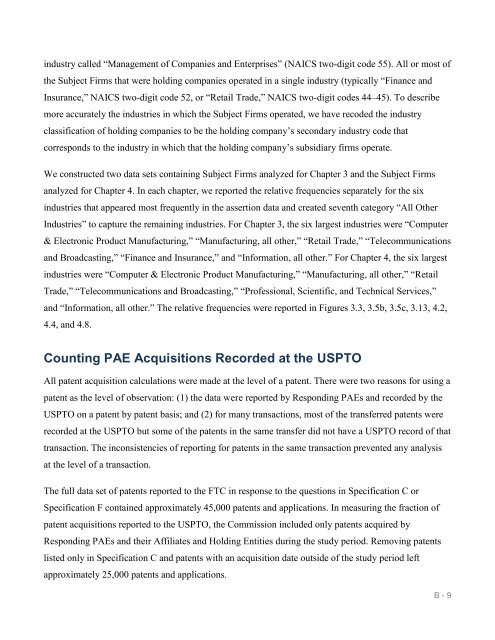You also want an ePaper? Increase the reach of your titles
YUMPU automatically turns print PDFs into web optimized ePapers that Google loves.
industry called “Management of Companies and Enterprises” (NAICS two-digit code 55). All or most of<br />
the Subject Firms that were holding companies operated in a single industry (typically “Finance and<br />
Insurance,” NAICS two-digit code 52, or “Retail Trade,” NAICS two-digit codes 44–45). To describe<br />
more accurately the industries in which the Subject Firms operated, we have recoded the industry<br />
classification of holding companies to be the holding company’s secondary industry code that<br />
corresponds to the industry in which that the holding company’s subsidiary firms operate.<br />
We constructed two data sets containing Subject Firms analyzed for Chapter 3 and the Subject Firms<br />
analyzed for Chapter 4. In each chapter, we reported the relative frequencies separately for the six<br />
industries that appeared most frequently in the assertion data and created seventh category “All Other<br />
Industries” to capture the remaining industries. For Chapter 3, the six largest industries were “Computer<br />
& Electronic Product Manufacturing,” “Manufacturing, all other,” “Retail Trade,” “Telecommunications<br />
and Broadcasting,” “Finance and Insurance,” and “Information, all other.” For Chapter 4, the six largest<br />
industries were “Computer & Electronic Product Manufacturing,” “Manufacturing, all other,” “Retail<br />
Trade,” “Telecommunications and Broadcasting,” “Professional, Scientific, and Technical Services,”<br />
and “Information, all other.” The relative frequencies were reported in Figures 3.3, 3.5b, 3.5c, 3.13, 4.2,<br />
4.4, and 4.8.<br />
Counting PAE Acquisitions Recorded at the USPTO<br />
All patent acquisition calculations were made at the level of a patent. There were two reasons for using a<br />
patent as the level of observation: (1) the data were reported by Responding PAEs and recorded by the<br />
USPTO on a patent by patent basis; and (2) for many transactions, most of the transferred patents were<br />
recorded at the USPTO but some of the patents in the same transfer did not have a USPTO record of that<br />
transaction. The inconsistencies of reporting for patents in the same transaction prevented any analysis<br />
at the level of a transaction.<br />
The full data set of patents reported to the FTC in response to the questions in Specification C or<br />
Specification F contained approximately 45,000 patents and applications. In measuring the fraction of<br />
patent acquisitions reported to the USPTO, the Commission included only patents acquired by<br />
Responding PAEs and their Affiliates and Holding Entities during the study period. Removing patents<br />
listed only in Specification C and patents with an acquisition date outside of the study period left<br />
approximately 25,000 patents and applications.<br />
B - 9


